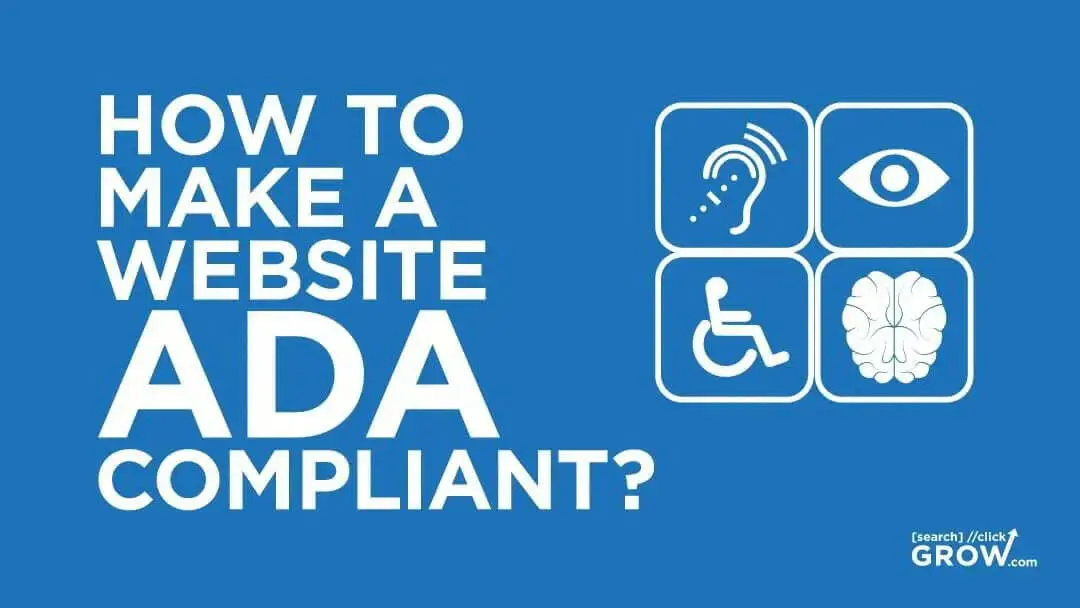
How to Make A Website ADA Compliant? A Free Checklist
ADA is shorthand for the Americans with Disabilities Act.
This federal legislation protects the rights of employees with disabilities. In the workplace, ADA requires both public and private-sector employers to make reasonable accommodations for employees with disabilities.
Online, ADA applies to websites too. They must be accessible, and they must communicate effectively to people who may have sight, hearing or speech impairment.
Otherwise, the person or entity behind the website is vulnerable to lawsuits.
In this article, we will go into detail about how ADA applies to websites, why it’s important, and we will also provide you with a checklist to help you get you started.
Here’s a breakdown of the main points we will cover:
- What is ADA Compliance and who does it affect
- What does ADA Compliance mean for websites
- How to make a website ADA Compliant (Checklist)
What is ADA Compliance and Who Does It Affect?
Government entities must meet the guidelines of the Americans with Disabilities Act in the workplace, in public buildings and also online.
Schools and universities with online learning must provide equally for all students with ADA-compliant courses.
Although no specific legislation requires private companies to have ADA-compliant websites, people with disabilities have increasingly brought lawsuits against those that are not.
In 2018 alone, people filed 2,285 lawsuits for non-ADA compliance. Such mega-firms as Netflix, Domino’s Pizza and Nike have all been subject to such legal actions.
The risk of a lawsuit is not the only reason you should make your website ADA compatible, though.
If you don’t put out the welcome mat for people with disabilities, they are likely to go to another site that does accommodate special needs.
Lack of specific ADA-friendly features, such as alternate text for images, sight-reader compatible forms and uniform navigation may even lower your search engine rankings.
What Does ADA Compliance Mean for Websites?
When the ADA became law in 1990, the internet was in its infancy. No one saw a need for mentioning website accessibility.

Currently, due to the need for everyone to be able to navigate the online environment, the U.S. Department of Justice is working on how the Americans with Disabilities Act applies to the virtual world.
Meanwhile, other dependable guidelines for compliance are available. The Website Content Accessibility Guidelines are a good go-to resource for making your website more ADA-oriented.
Created by a subcommittee of the World Wide Web Consortium, WCAG first came out in 1999. The Consortium updated the document in 2018.
These guidelines and principles provide critical information for people like you who need to know how to make a website ADA compliant.
Let’s take a look at the four Principles of Accessibility and its guidelines!
What Are the Four Principles of Accessibility
Principle #1: Perceivable
Images, charts and other visuals on your website need to have a text equivalent for sight-impaired users.
Exceptions to this guideline include:
- Time-sensitive media
- A test or learning exercise requiring non-text components

- CAPTCHA functions, which should have an audio alternative
- Decorative elements.
If your website has any audio or video, you should offer the content in an alternative media for persons with impairments.
For example, your website videos should have basic text alternatives while your audio-only media needs to have written captions and/or sign language if it is live.
Here’s other important guidelines that should be followed:
- Information, headings, colors and navigation controls on each page should display correctly on large and small screens alike.
- They should translate correctly if someone is using a page viewer to browse the website.
- The site creator needs to take care to preserve the integrity of the website through programming.
- Images, text and audio should be easy to distinguish from each other.
- Colors should contrast enough that someone who cannot easily see color can still see the differences.
- Text size and spacing should enhance readability.
Principle #2: Operable
 People without the mobility to scroll or otherwise manipulate the page content should be able to access a full range of functions via their keyboards. This means:
People without the mobility to scroll or otherwise manipulate the page content should be able to access a full range of functions via their keyboards. This means:
- Single-letter shortcuts must have an on/off function and be active only when a particular component is the user’s focus.
- If any element is timed, that timing should be adjustable so that each user has enough time to benefit.
- Users should also be able to stop scrolling, blinking or otherwise moving information.
- Users should be able to pause any automatic updates that interrupt their experience on your website.
- If your website times out after a certain interval, requiring users to re-authenticate their login information, they must be able to continue afterwards without losing any of their data or their place on the page.
- To prevent physical reactions from users prone to seizures, your site should not contain elements that flash more than three times per second. Also, any moving animation you have should have the option for the user to turn it off.
- In terms of operable navigation, users should be able to avoid any repetitive content that hinders their user experience. Each of your pages should have an exclusive topic and heading.
- Links on your website should have a purpose that the link text clearly states.
- When someone is navigating your site, they should be able to go forward and back as needed with at least two navigation options on each page.
In addition, your web designer should ensure that any pointer targets on a page are large enough for ease of navigation and have a clear purpose.
Principle #3: Understandable
 Make sure that your designer programs website content in an easily-understandable language your users are most likely to comprehend.
Make sure that your designer programs website content in an easily-understandable language your users are most likely to comprehend.
Here are the guidelines you should follow:
- Providing definitions and/or phonetic help for words that are unusually difficult for the average reader.
- If your text includes abbreviations, your user should be able to easily determine what they mean.
- The pages of your website should be consistent. For example, you should arrange information blocks in a pattern that enables visitors to locate what they need throughout the site.
- If a user makes a mistake when inputting data on a form, your system should provide error information and solutions.
- Users should be able to undo errors they make.
- Your system should confirm and/or correct any input.
Principle #4: Robust
A robust website is one that coordinates with a diverse user population using various assistive technologies.
Those technologies include:
- Screen readers that convert web text to speech or Braille
- Optical character recognition software
- Magnification software
- Voice recognition software
- Adapted or on-screen keyboards
- Sip and puff systems
- Joysticks
- Electronic pointers
- Touch screen technology

Robust websites include programmable accommodations such as parsing to ensure coded language is completely accessible to assistive technologies and they also provide status messages that help users identify and overcome snafus.
ADA-Compliant Checklist for Website Design
First, different users have different special needs that a website must accommodate.
Secondly, much of the compliance issues are behind the scenes and go undetected until someone encounters obstructions.
Thirdly, the lion’s share of ADA compliance rests on the designer’s or web tech’s shoulders, so they are unclear to website owners who lack specialized training.
The following simplified checklist for how to make a website ADA-compliant may help:
- Use the right contrast ratio so that sight-impaired individuals can view your content more easily.
- Do not depend upon the use of color to communicate because some cannot distinguish color.
- Forms should include a clear label for each empty information box to accommodate screen readers.
- Include error message technology to help guide users and ease frustration, but use a combination of colors, symbols, and text.
- Your website should be accessible through a keyboard only for users who cannot manipulate a mouse.
- To eliminate confusion, navigation buttons, icons, and setup should be consistent throughout the website. The site map and search functions should be accessible from each page.
- Your headings should be clear, visible, and generously spaced to enhance readability.
- Your website should allow users to control slideshows and videos with pause, replay, and advance options.
- Make your website clearly readable and ADA accessible on different devices such as phones, tablets, and PCs.
- Your content should offer links to alternate formats. For example, photos should have alternative text. Charts and tables should have audio descriptions for those who cannot see them.
ADA Guidelines Help Everyone
Many of the guidelines for an ADA-compliant website make it easier and more accessible to all your users. Clear text, more color contrast, white spaces and uniform navigation makes your site more engaging and useful to people with and without disabilities.
The alternative – a non-ADA compliant website – may bring you publicity you can do without. Domino’s Pizza learned that lesson the hard way as the defendant in a much-publicized lawsuit.
A sight-impaired man found he couldn’t order a pizza on Domino’s website because it wasn’t compatible with his screen reader.
As a result of the legal battle, the iconic pizza chain suffered financial losses as well as a blow to its reputation. Most people who run into roadblocks online will simply go elsewhere to do business rather than raising their voices in protest.
According to a 2016 survey by Click-Away Pound, a UK firm, 71 percent of users with disabilities quickly navigate elsewhere when they experience difficulties with the site they are on. This silent migration can cost a business dearly.
In contrast, firms that proactively address ADA guidelines do more than avoid business losses. They experience upticks in web traffic that can actually pay for their efforts.
For example, National Public Radio creates FCC-compliant transcripts for its popular program, “This American Life.” As a result, the show has experienced measurable increases in traffic, searches, and inbound links.
Search Click Grow Can Help
Now is the best time to upgrade your website to resolve any ADA-compliance issues. Your first step in to get in touch with an experienced website firm that knows how to help your business grow.
At Search Click grow, we use a proven four-phase program to take your online presence from entry-level to market leader. Our specialists have the know-how to bring your web technology forward into a diverse world of possibilities.
The risk of a lawsuit is not the only reason you should make your website ADA compatible, though. If you don’t put out the welcome mat for people with disabilities, they are likely to go to another site that does accommodate special needs.
Lack of specific ADA-friendly features, such as alternate text for images, sight-reader compatible forms and uniform navigation may even lower your search engine rankings.
With free marketing training information, regular topical insights, we offer a clear path to get your website where you want it to be. Get in touch with us today for more information on ADA compliance for a more customer-friendly experience.







